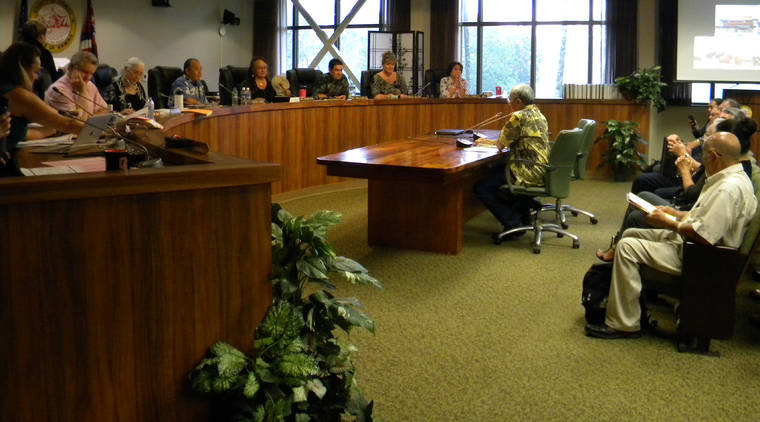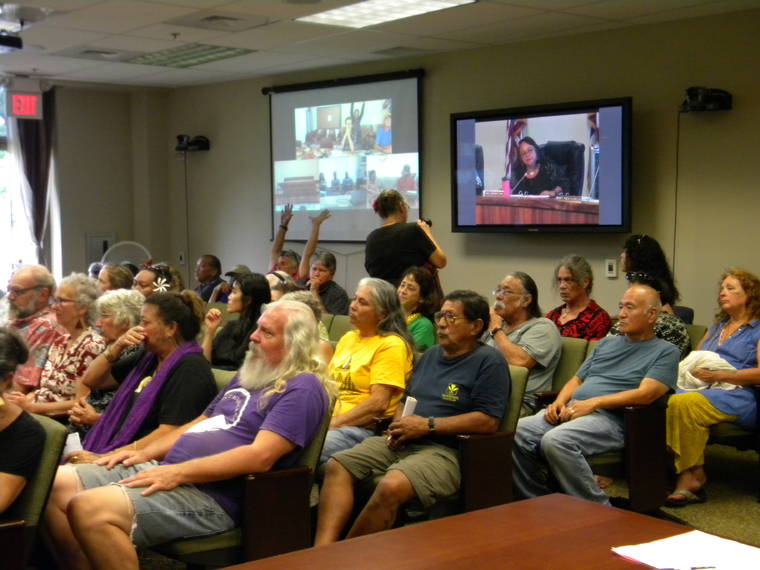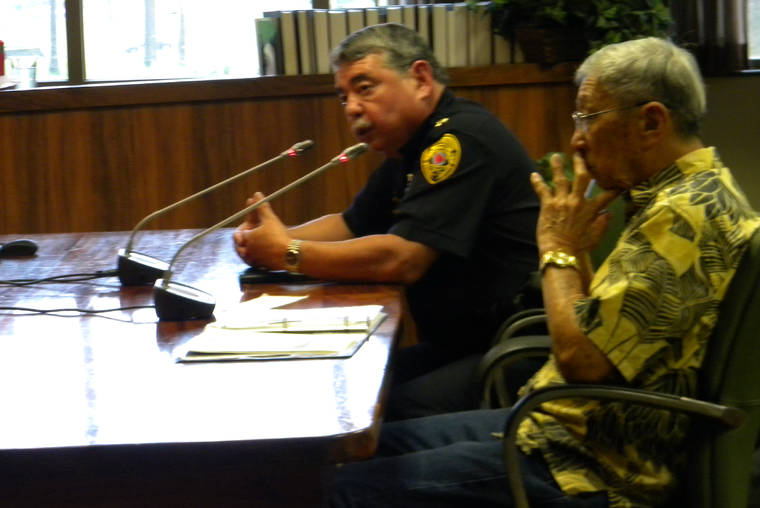Maunakea on the mind. Council committee hears concerns about police protecting TMT

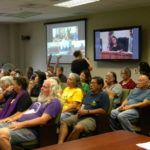
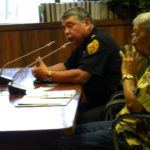
HILO — Prayers, chants and tears — and an outburst or two — marked an afternoon of testimony Monday as more than 50 people shared their mana‘o about Maunakea and the impending construction of a massive telescope there.
It was an opportunity for the people to address at a county forum what is essentially a state issue. In particular, people wanted to know how the county police force will act as the state’s agent in keeping peace and at what cost to county taxpayers.
The briefing comes at the start of planned construction of the 180-foot-tall state-of-the-art observatory, after a notice to proceed was issued last month. There are already 13 telescopes on the mountain, but some of the older telescopes will be taken down as part of the construction plan.
Mayor Harry Kim tried to defuse the tension with the announcement that he’s gotten Gov. David Ige’s permission to talk about a new “umbrella” management structure for the mountain that will include the Office of Hawaiian Affairs, the Royal Order of Kamehameha, Queen Liliuokalani and other Native Hawaiian groups. More details will come later, he said.
“There’s a lot of anger up there that we as non-Hawaiians don’t understand,” Kim said. “It goes back to 1894. Let these words be more than just words. … The issue is not just Maunakea for me and the telescope.”
Police Chief Paul Ferreira agreed.
“This is a long-term vision. It’s not about Maunakea and the telescope,” Ferreira said. “It’s about the Hawaiian sovereignty movement.”
Protests against the $1.4 billion project interrupted groundbreaking in 2014 and halted construction the following year prior to the state Supreme Court overturning its land use permit because of due process violations. Dozens of protesters, who call themselves protectors of a sacred mountain, were arrested for blocking construction equipment’s access to the mountain.
To some degree, the telescope has become the line in the sand for Native Hawaiians.
“This is a huge very sensitive, sensitive issue,” said South Kona/Ka‘u Councilwoman Maile David, a Native Hawaiian. “This is like the final frontier on whether the Native Hawaiian rights are going to be protected like it was meant to be.”
Puna Councilman Matt Kanealii-Kleinfelder cited a recent negative experience on the mountain as one of the reasons he put the discussion on the council Finance Committee agenda. Kanealii-Kleinfelder said he and his family went up to stargaze and found the area dark, the visitor center closed, the security staff unfriendly and the public telescopes unavailable.
“I did not get a sense of anything even aloha being offered on that mountain,” Kanealii-Kleinfelder said. “It doesn’t matter what side we’re on. It comes down to how we’re taking care of the people who live here and who are visiting.”
There’s no estimate of the cost, although Kim has said the state will pay the county back.
“It’s unfortunate that we’re using police force to protect a corporation rather than using police force to protect our people,” said Hamakua Councilwoman Valerie Poindexter. “This is our kuleana — all of us who live here.”
Ultimately, there’s little the county can do.
“I’m at a loss where to go from here,” said North Kona Councilwoman Karen Eoff. “I’m not sure we have any say-so on spending on the police.”
Several testifiers decried police policy of requiring officers to be assigned to security on the mountain in the event of a protest. This will pin brother against brother, forcing officers who believe in the protectors’ cause to have to arrest their own family, testifiers said.
But Ferreira said officers take an oath to enforce the law when they become part of the police force. If officers are allowed, as opponents call it, to become conscientious objectors on this issue, what’s to stop officers from refusing to enforce laws protecting gay rights and abortion clinics or any other controversial subject, Ferreira said.
“We don’t take a position as far as pro or anti but we did take a oath to do our duty,” he said.
Both Ferreira and Kim talked about a vision for Maunakea that sees the protection of cultural rights working alongside instruments of advanced science.
“(I envision) Maunakea to be a symbol of nations working together for the pursuit of peace and harmony, a beacon of hope and discovery for the world,” Kim said, reading from his formal vision for the mountain. “This is not just about science. It is about combining culture and science.”
Testifiers remained skeptical, especially about a police presence.
“We don’t need them up there. We’re peaceful people,” said Cindy Frietas. “We need them down here.”
“I’m a taxpayer,” said Josephine Keliipio. “I don’t want the police department up there harming the protectors.”
With the three or four TMT supporters who testified as well as several of the Maunakea protectors saying they’ve gotten death threats, Pua Case asked the council to find out exactly what kind of confrontation is expected once the construction equipment starts rolling.
“We come in here and we’re not just some Hawaiians. We’re many different people,” Case said. “What are we going to be facing?”
Whatever it is and no matter how much taxpayer money gets spent, the opponents plan to continue the battle against telescope construction.
“We’ll run you broke,” said Hanalei Fergerstrom. “We are about protecting the most sacred place on Earth to us.”

